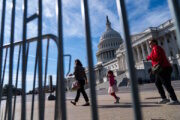TOKYO (AP) — The Japanese economy shrank at an annual rate of 1.8% in the first quarter of this year, slightly better than the initial estimate at a 2.0% contraction, according to revised government data Monday.
The revision was due to private sector investments, at minus 0.4%, up from the previous minus 0.5%.
Seasonally adjusted real gross domestic product, or GDP, a measure of the value of a nation’s products and services, remained in negative territory, as exports and consumption declined from the previous quarter.
Quarter-to-quarter, the economy slipped 0.5% in the January-March period, according to the Cabinet Office, unchanged from last month’s results.
The annual rate measures what would have happened if the quarterly rate lasted a year.
Wage growth has been slow, and prices on imports have risen amid a decline in the Japanese yen against the U.S. dollar. The dollar is trading at nearly 157 yen lately, up from about 140 yen a year ago.
The weak yen has tourism booming. But it makes imports more expensive, a sore point for a nation that imports almost all its energy. Sluggish consumer spending has also been a drag on the economy. Private consumption accounts for half of Japanese economic activity.
Another negative is the ongoing scandal involving improper vehicle model tests at several major automakers, including Toyota Motor Corp., which form the pillars of Japan’s brand power. Production was halted on some models.
Government officials raided the Tokyo headquarters of Honda Motor Co. Monday. Japanese media reports said a raid was coming soon on Mazda Motor Corp. Toyota and Suzuki Motor Corp. have already been raided.
Last week, Toyota Chairman Akio Toyoda apologized for the wide-ranging fraudulent testing involving the use of inadequate or outdated data in collision tests, incorrect testing of airbag inflation, rear-seat damage in crashes and engine power.
The safety of the vehicles aren’t affected, but the companies apparently wanted to speed up the testing process.
Investors are also watching closely for the next action from the Bank of Japan, whose monetary policy board meets later this week. The central bank raised interest rates earlier this year for the first time since 2007, but only to a range of zero to 0.1% from minus 0.1%.
“The Japanese central bank’s stance will similarly be eyed closely, especially with the domestic currency weakness prevailing. Japanese manufacturers are facing the fastest rise in input costs,” S&P Global Market Intelligence said in a report.
Unemployment has stayed relatively low in the world’s fourth largest economy at about 2.6%. Japan suffers a serious labor shortage, as its birth rate continues to drop, hitting a record low last year. The number of marriages have also fallen.
Such demographic trends could prove more dangerous in the long run, according to some analysts, who worry Japan is especially weak in per capita output, and its dimming clout on the global stage might even lead to security risks.
Japan’s GDP is expected to slip to No. 5 in magnitude after the U.S., China, Germany and India next year, according to the IMF.
___
Yuri Kageyama is on X: https://twitter.com/yurikageyama
Copyright © 2024 The Associated Press. All rights reserved. This material may not be published, broadcast, written or redistributed.







